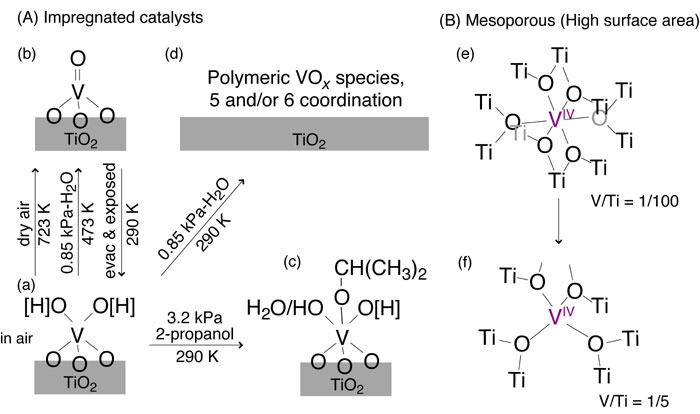
X-ray Absorption Fine Structure Combined with X-ray Fluorescence Spectrometry. Monitoring of Vanadium Site Transformations on Titania and in Mesoporous Titania by Selective Detection of the Vanadium K alpha1 Fluorescence |
X-ray absorption fine structure combined with X-ray fluorescence spectrometry was applied to various V+TiO2 hybrid samples. Emitted V Ka1 fluorescence from the sample was selectively counted by using high-energy-resolution (0.4 eV) spectrometer equipped with a Ge(331) crystal. Two advantages of this method, extremely high signal/background ratio and the compatibility of measurements in the atmosphere of reaction gas (in-situ study in relation to heterogeneous catalysis), were effective at the V K-edge. Structure transformation of the V sites was spectroscopically followed for the V/TiO2 catalyst. Monooxo tetrahedral vanadate site was demonstrated to exist at 473 K. It transformed into dispersed species of 5-fold coordination in ambient air and further into polymeric VOx species in 0.85 kPa of water at 290 K. In the presence of 3.2 kPa of 2-propanol, dissociative adsorption of 2-propanol on the dispersed V species was strongly suggested at 290 - 473 K. In-situ structure changes of V sites on TiO2 were reported by means of XAFS for the first time. The V(V) sites for the V/TiO2 catalysts were essentially identical with those for V supported on mesoporous (high-surface-area) TiO2 and V-TiO2 sample prepared by sol-gel method. However, predominant V(IV) sites were found for mesoporous V-TiO2. The V(IV) sites substituted on the Ti sites of TiO2. When the molar ratio of V/Ti increased from 1/100 to 1/5.0, major octahedral V sites in TiO2 matrix looked to transform into tetrahedral ones.

Chiba University > Graduate School of Science > Department of Chemistry > Dr. Yasuo Izumi Group